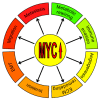MYC as a Multifaceted Regulator of Tumor Microenvironment Leading to Metastasis
- PMID: 33081056
- PMCID: PMC7589112
- DOI: 10.3390/ijms21207710
MYC as a Multifaceted Regulator of Tumor Microenvironment Leading to Metastasis
Abstract
The Myc family of oncogenes is deregulated in many types of cancer, and their over-expression is often correlated with poor prognosis. The Myc family members are transcription factors that can coordinate the expression of thousands of genes. Among them, c-Myc (MYC) is the gene most strongly associated with cancer, and it is the focus of this review. It regulates the expression of genes involved in cell proliferation, growth, differentiation, self-renewal, survival, metabolism, protein synthesis, and apoptosis. More recently, novel studies have shown that MYC plays a role not only in tumor initiation and growth but also has a broader spectrum of functions in tumor progression. MYC contributes to angiogenesis, immune evasion, invasion, and migration, which all lead to distant metastasis. Moreover, MYC is able to promote tumor growth and aggressiveness by recruiting stromal and tumor-infiltrating cells. In this review, we will dissect all of these novel functions and their involvement in the crosstalk between tumor and host, which have demonstrated that MYC is undoubtedly the master regulator of the tumor microenvironment. In sum, a better understanding of MYC's role in the tumor microenvironment and metastasis development is crucial in proposing novel and effective cancer treatment strategies.
Keywords: EMT; MYC; TAMs; metastasis; tumor microenvironment.
Conflict of interest statement
The authors declare no conflict of interest.
Figures



References
Publication types
MeSH terms
Substances
LinkOut - more resources
Full Text Sources

